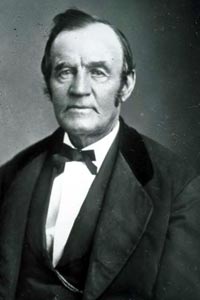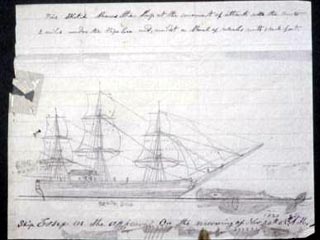The Essex
It is believed that Melville based Moby Dick on several real-life events, one of which was the sinking of the whaling ship Essex by a sperm whale. On November 20, 1820, the Essex was attacked by a sperm whale and sank 2,000 miles off South America. Eight sailors were rescued five months later on April 5, 1821. Owen Chase, the first mate, and Thomas Nickerson, the cabin boy, both wrote accounts of the disaster that are believed to have been source material for Moby Dick.[1]

Thomas Nickerson as an adult. Nickerson was the cabin boy on the Essex. Nickerson, only 15 years-old at the time, was at the helm when the whale attacked and was the first to sight it. [2]
The Essex was 87 feet long, displaced 238 tons unladen, and was powered by 12 sails. It was small for a whaler, with a crew of only 21, but it had had success on previous voyages and (ironically) had earned a reputation as a “lucky” ship. [3]

A sketch made by Thomas Nickerson depicting the Essex being attacked by a whale.[4]
Living quarters on the Essex were divided into three areas. The captain and the two mates had cabins to the rear, the white members of the crew live in the steerage section, and African-American sailors occupied the forecastle at the front of the ship. As was typical on whaling ships, whale blubber, barrels, provisions, spare sails, and ropes were stored in the hold. The Essex left Nantucket with 1,200 empty barrels in its hold, which it hoped to fill with whale oil by the end of the two-and-a-half year voyage. The voyage was of course cut short. [5]

Diagram of the Essex[6]
The Essex was fitted with four specialized whaleboats of approximately 25 feet in length that were launched from the ship when a whale was sited. Built for speed rather than durability, these boats were “Clinker built,” with planks that overlapped rather than lying flush with each other.